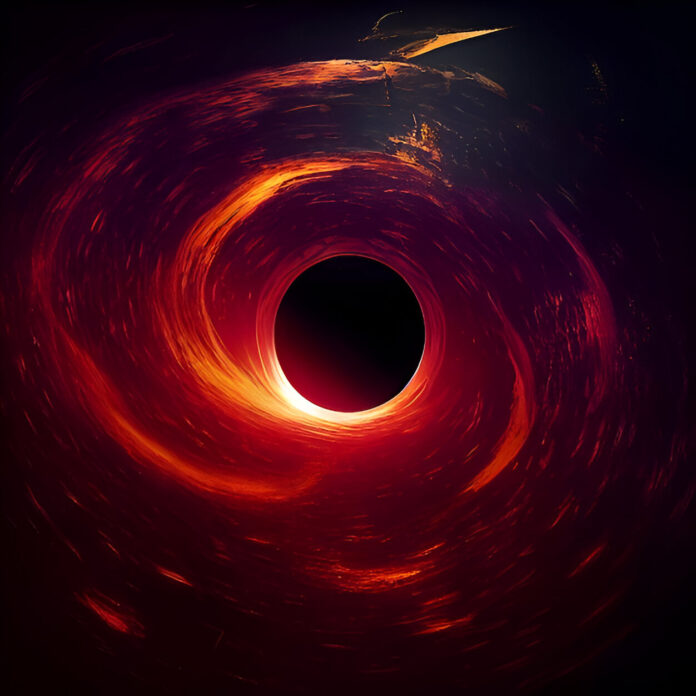The James Webb Space Telescope (JWST) is revolutionizing our understanding of the early universe, revealing a “red giant” black hole existing just a billion years after the Big Bang. This discovery challenges existing theories due to the black hole’s unexpected size and dusty environment. Supermassive black holes typically reside at galaxy cores, influencing their formation and evolution. However, this anomaly, shrouded in dust, raises questions about its early formation and growth, prompting further investigation and potentially rewriting our understanding of these cosmic giants.
The “Red Giant” Black Hole
The black hole’s immense distance means it appears to us as it existed less than a billion years after the Big Bang. The light from this ancient object is profoundly “redshifted.” This cosmic stretching of light wavelengths is a direct consequence of the universe’s ongoing expansion, and in this case, it gives the black hole a distinct red hue. That redness, however, comes not from the black hole itself but from a thick veil of cosmic dust and gas that obscures it.
A team of astronomers, pouring over the treasure trove of JWST data, spotted this unusual object and quickly recognized its significance. They realized that the surprisingly massive object hidden behind the dust cloud must be a supermassive black hole at the heart of a young galaxy.
Supermassive and Growing Fast
Just how massive is this early universe monster? Estimates suggest that the red giant black hole weighs in at a staggering 40 million times the mass of our sun. This colossal size places it in the category of supermassive black holes. Intriguingly, this mass is exceptionally large for this early cosmic epoch, and its hefty size relative to its host galaxy poses intriguing questions about how such objects arise.
Furthermore, the supermassive black hole is not just sitting idly. Data suggests that it is actively and voraciously consuming surrounding gas and dust, fueling its rapid growth. This process is thought to be relatively slow, with black holes accumulating mass incrementally over billions of years. However, the JWST discovery throws a wrench into these established theories. The sheer size of the “red giant” black hole, existing just a billion years after the Big Bang, presents a significant challenge. In the standard model, such rapid growth within such a short timeframe simply wouldn’t be possible, leaving scientists scratching their heads and potentially prompting a revision of our understanding of supermassive black hole formation and early universe dynamics.
The Quasar Unveiled
The intense feeding frenzy taking place around this black hole is the key to understanding its appearance. As matter swirls into the black hole’s grasp, it forms a swirling disk known as an accretion disk. The colossal gravitational forces at play heat this disk to extreme temperatures, causing it to emit a blindingly bright light. This phenomenon creates what astronomers call a quasar. Often, quasars driven by supermassive black holes can outshine the light from all the stars in their host galaxies combined.
However, in this case, the thick shroud of dust obscures much of the quasar’s dazzling light. It’s this cosmic filtering that lends the object its distinctly red color, allowing it to be picked out by the powerful infrared vision of the James Webb Space Telescope.
Einstein’s Helping Hand
Even with JWST’s capabilities, directly detecting this distant red giant black hole would be difficult. Yet, nature provided a cosmic assist in the form of gravitational lensing. As predicted by Einstein’s theory of general relativity, massive objects like galaxy clusters warp the fabric of spacetime. This warping can then bend and magnify light from more distant objects, acting like a giant cosmic magnifying glass.
In this instance, a galaxy cluster named Abell 2744 served as the lens to amplify the light of the distant quasar. This magnification effect made the shrouded quasar visible to JWST and helped astronomers unravel its true nature.
Mysteries of the Early Universe
The discovery of this red giant black hole helps paint a clearer picture of the young universe and the processes that shaped it. Supermassive black holes are thought to reside at the hearts of most galaxies, including our own Milky Way, but how they came to be so early in the universe is a profound puzzle.
Did they grow from smaller “seed” black holes left over from the deaths of the first stars? Or perhaps even more foreign are at play. This discovery, along with other JWST finds, may offer key clues as to how these cosmic behemoths came to exist and how they influenced the galaxies we observe today.
